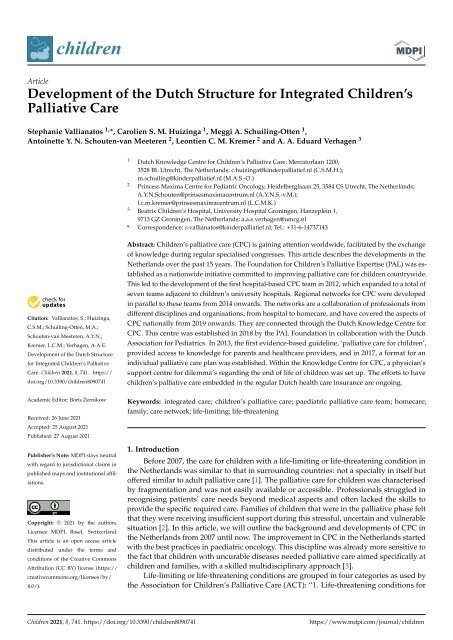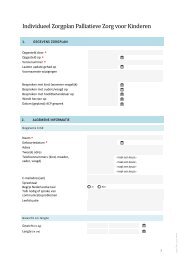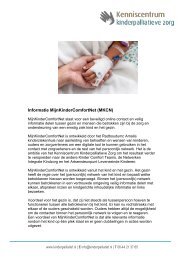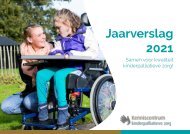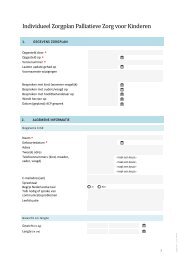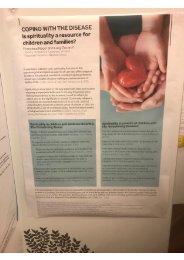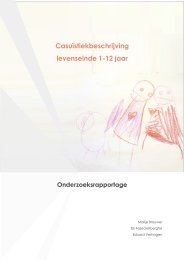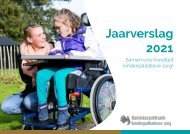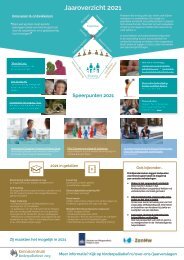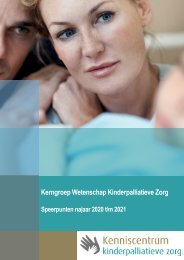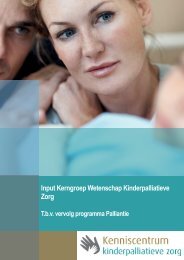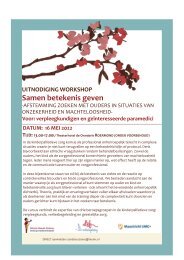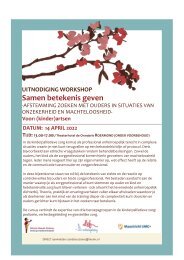Development of the Dutch Structure for Integrated Children’s Palliative Care
You also want an ePaper? Increase the reach of your titles
YUMPU automatically turns print PDFs into web optimized ePapers that Google loves.
children<br />
Article<br />
<strong>Development</strong> <strong>of</strong> <strong>the</strong> <strong>Dutch</strong> <strong>Structure</strong> <strong>for</strong> <strong>Integrated</strong> <strong>Children’s</strong><br />
<strong>Palliative</strong> <strong>Care</strong><br />
Stephanie Vallianatos 1, *, Carolien S. M. Huizinga 1 , Meggi A. Schuiling-Otten 1 ,<br />
Antoinette Y. N. Schouten-van Meeteren 2 , Leontien C. M. Kremer 2 and A. A. Eduard Verhagen 3<br />
1 <strong>Dutch</strong> Knowledge Centre <strong>for</strong> <strong>Children’s</strong> <strong>Palliative</strong> <strong>Care</strong>, Mercatorlaan 1200,<br />
3528 BL Utrecht, The Ne<strong>the</strong>rlands; c.huizinga@kinderpalliatief.nl (C.S.M.H.);<br />
m.schuiling@kinderpalliatief.nl (M.A.S.-O.)<br />
2 Princess Maxima Centre <strong>for</strong> Pediatric Oncology, Heidelberglaaan 25, 3584 CS Utrecht, The Ne<strong>the</strong>rlands;<br />
A.Y.N.Schouten@prinsesmaximacentrum.nl (A.Y.N.S.-v.M.);<br />
l.c.m.kremer@prinsesmaximacentrum.nl (L.C.M.K.)<br />
3 Beatrix <strong>Children’s</strong> Hospital, University Hospital Groningen, Hanzeplein 1,<br />
9713 GZ Groningen, The Ne<strong>the</strong>rlands; a.a.e.verhagen@umcg.nl<br />
* Correspondence: s.vallianatos@kinderpalliatief.nl; Tel.: +31-6-14737143<br />
<br />
<br />
Citation: Vallianatos, S.; Huizinga,<br />
C.S.M.; Schuiling-Otten, M.A.;<br />
Schouten-van Meeteren, A.Y.N.;<br />
Kremer, L.C.M.; Verhagen, A.A.E.<br />
<strong>Development</strong> <strong>of</strong> <strong>the</strong> <strong>Dutch</strong> <strong>Structure</strong><br />
<strong>for</strong> <strong>Integrated</strong> <strong>Children’s</strong> <strong>Palliative</strong><br />
<strong>Care</strong>. Children 2021, 8, 741. https://<br />
doi.org/10.3390/children8090741<br />
Abstract: <strong>Children’s</strong> palliative care (CPC) is gaining attention worldwide, facilitated by <strong>the</strong> exchange<br />
<strong>of</strong> knowledge during regular specialised congresses. This article describes <strong>the</strong> developments in <strong>the</strong><br />
Ne<strong>the</strong>rlands over <strong>the</strong> past 15 years. The Foundation <strong>for</strong> <strong>Children’s</strong> <strong>Palliative</strong> Expertise (PAL) was established<br />
as a nationwide initiative committed to improving palliative care <strong>for</strong> children countrywide.<br />
This led to <strong>the</strong> development <strong>of</strong> <strong>the</strong> first hospital-based CPC team in 2012, which expanded to a total <strong>of</strong><br />
seven teams adjacent to children’s university hospitals. Regional networks <strong>for</strong> CPC were developed<br />
in parallel to <strong>the</strong>se teams from 2014 onwards. The networks are a collaboration <strong>of</strong> pr<strong>of</strong>essionals from<br />
different disciplines and organisations, from hospital to homecare, and have covered <strong>the</strong> aspects <strong>of</strong><br />
CPC nationally from 2019 onwards. They are connected through <strong>the</strong> <strong>Dutch</strong> Knowledge Centre <strong>for</strong><br />
CPC. This centre was established in 2018 by <strong>the</strong> PAL Foundation in collaboration with <strong>the</strong> <strong>Dutch</strong><br />
Association <strong>for</strong> Pediatrics. In 2013, <strong>the</strong> first evidence-based guideline, ‘palliative care <strong>for</strong> children’,<br />
provided access to knowledge <strong>for</strong> parents and healthcare providers, and in 2017, a <strong>for</strong>mat <strong>for</strong> an<br />
individual palliative care plan was established. Within <strong>the</strong> Knowledge Centre <strong>for</strong> CPC, a physician’s<br />
support centre <strong>for</strong> dilemma’s regarding <strong>the</strong> end <strong>of</strong> life <strong>of</strong> children was set up. The ef<strong>for</strong>ts to have<br />
children’s palliative care embedded in <strong>the</strong> regular <strong>Dutch</strong> health care insurance are ongoing.<br />
Academic Editor: Boris Zernikow<br />
Received: 26 June 2021<br />
Accepted: 25 August 2021<br />
Published: 27 August 2021<br />
Publisher’s Note: MDPI stays neutral<br />
with regard to jurisdictional claims in<br />
published maps and institutional affiliations.<br />
Copyright: © 2021 by <strong>the</strong> authors.<br />
Licensee MDPI, Basel, Switzerland.<br />
This article is an open access article<br />
distributed under <strong>the</strong> terms and<br />
conditions <strong>of</strong> <strong>the</strong> Creative Commons<br />
Attribution (CC BY) license (https://<br />
creativecommons.org/licenses/by/<br />
4.0/).<br />
Keywords: integrated care; children’s palliative care; paediatric palliative care team; homecare;<br />
family; care network; life-limiting; life-threatening<br />
1. Introduction<br />
Be<strong>for</strong>e 2007, <strong>the</strong> care <strong>for</strong> children with a life-limiting or life-threatening condition in<br />
<strong>the</strong> Ne<strong>the</strong>rlands was similar to that in surrounding countries: not a specialty in itself but<br />
<strong>of</strong>fered similar to adult palliative care [1]. The palliative care <strong>for</strong> children was characterised<br />
by fragmentation and was not easily available or accessible. Pr<strong>of</strong>essionals struggled in<br />
recognising patients’ care needs beyond medical aspects and <strong>of</strong>ten lacked <strong>the</strong> skills to<br />
provide <strong>the</strong> specific required care. Families <strong>of</strong> children that were in <strong>the</strong> palliative phase felt<br />
that <strong>the</strong>y were receiving insufficient support during this stressful, uncertain and vulnerable<br />
situation [2]. In this article, we will outline <strong>the</strong> background and developments <strong>of</strong> CPC in<br />
<strong>the</strong> Ne<strong>the</strong>rlands from 2007 until now. The improvement in CPC in <strong>the</strong> Ne<strong>the</strong>rlands started<br />
with <strong>the</strong> best practices in paediatric oncology. This discipline was already more sensitive to<br />
<strong>the</strong> fact that children with uncurable diseases needed palliative care aimed specifically at<br />
children and families, with a skilled multidisciplinary approach [3].<br />
Life-limiting or life-threatening conditions are grouped in four categories as used by<br />
<strong>the</strong> Association <strong>for</strong> <strong>Children’s</strong> <strong>Palliative</strong> <strong>Care</strong> (ACT): “1. Life-threatening conditions <strong>for</strong><br />
Children 2021, 8, 741. https://doi.org/10.3390/children8090741<br />
https://www.mdpi.com/journal/children
Children 2021, 8, 741 2 <strong>of</strong> 8<br />
which curative treatment may be feasible but can fail—<strong>for</strong> example: cancer, organ failure<br />
<strong>of</strong> <strong>the</strong> heart, liver, kidney; 2. Conditions where premature death is inevitable—children in<br />
this category may be severely disabled but have long periods <strong>of</strong> relatively good health—<br />
<strong>for</strong> example, Duchenne muscular dystrophy and SMA type 1; 3. Progressive conditions<br />
without curative treatment options—treatment focused on palliative care may last <strong>for</strong><br />
many years—<strong>for</strong> example, severe metabolic conditions; 4. Irreversible but non-progressive<br />
conditions causing severe disability, leading to susceptibility to health complications and<br />
likelihood <strong>of</strong> premature death—<strong>for</strong> example, complex disabilities such as brain or spinal<br />
cord injury” [4].<br />
1.1. <strong>Children’s</strong> <strong>Palliative</strong> <strong>Care</strong> Worldwide<br />
CPC is an integrated approach <strong>for</strong> children with a life-limiting or life-threatening<br />
condition, focusing on quality <strong>of</strong> life and good circumstances around death. Globally, we<br />
embrace <strong>the</strong> following World Health Organisation definition <strong>of</strong> CPC [1]: “<strong>Palliative</strong> care<br />
<strong>for</strong> children is <strong>the</strong> active total care <strong>of</strong> <strong>the</strong> child’s body, mind and spirit, and also involves<br />
giving support to <strong>the</strong> family. It begins when illness is diagnosed, and continues regardless<br />
<strong>of</strong> whe<strong>the</strong>r or not a child receives treatment directed at <strong>the</strong> disease. Health providers<br />
must evaluate and alleviate a child’s physical, psychological, and social distress. Effective<br />
palliative care requires a broad multidisciplinary approach that includes <strong>the</strong> family and<br />
makes use <strong>of</strong> available community resources; it can be successfully implemented even if<br />
resources are limited. It can be provided in tertiary care facilities, in community health<br />
centres and even in children’s homes.” Worldwide initiatives have evolved from <strong>the</strong><br />
urgent need <strong>for</strong> progress in <strong>the</strong> field <strong>of</strong> CPC with more in<strong>for</strong>mation, <strong>for</strong>malised networks<br />
and research to achieve <strong>the</strong> best possible quality <strong>of</strong> life <strong>for</strong> children with life-threatening<br />
conditions and <strong>for</strong> <strong>the</strong>ir families [4,5].<br />
CPC worldwide is a young discipline. Apart from England, specific provision <strong>of</strong> CPC<br />
was hardly visible in 1980 [6]. The first children’s hospice, <strong>the</strong> Helen House, opened in<br />
Ox<strong>for</strong>dshire (UK) in 1982. The International <strong>Children’s</strong> <strong>Palliative</strong> <strong>Care</strong> Network (ICPCN)<br />
was founded in 2005. The goal <strong>of</strong> <strong>the</strong> ICPCN is: “to achieve <strong>the</strong> best quality <strong>of</strong> life and<br />
care <strong>for</strong> children and young people with life-limiting conditions, <strong>the</strong>ir families and carers<br />
worldwide. Important tasks are improving awareness, lobbying <strong>for</strong> <strong>the</strong> global development<br />
<strong>of</strong> CPC services and sharing expertise, skills and knowledge”. [7]. Meanwhile <strong>the</strong> provision<br />
<strong>of</strong> CPC has improved worldwide, as demonstrated by <strong>the</strong> geographical map depicting<br />
2019 in Figure 1.<br />
1.2. Situation CPC in <strong>the</strong> Ne<strong>the</strong>rlands<br />
In <strong>the</strong> Ne<strong>the</strong>rlands, 5000–7000 children and <strong>the</strong>ir families are eligible <strong>for</strong> palliative<br />
care; and approximately 23% <strong>of</strong> <strong>the</strong>se children have an oncological disease, and 77% have<br />
a neonatal, neurological or metabolic disease, <strong>of</strong>ten in chronic condition. Annually, in total,<br />
around 1100 children (0–20 year) die [8]. Subsequently more chronic conditions and rare<br />
diseases in children are emerging <strong>the</strong> coming decades [9,10]. About 10.000 children with<br />
chronic conditions are known in hospitals and home care who are cared <strong>for</strong> and nursed over<br />
a period <strong>of</strong> many years. About 65% <strong>of</strong> this group is palliative, based on <strong>the</strong> WHO definition<br />
<strong>of</strong> paediatric palliative care [1]. In comparison, we highlight some figures about palliative<br />
care <strong>for</strong> adults: 110,000 adults per year receive palliative care in <strong>the</strong> Ne<strong>the</strong>rlands, most<br />
<strong>of</strong>ten because <strong>of</strong> an oncological disease, cardiac or vascular disease, respiratory disease<br />
and/or dementia [11]. Fur<strong>the</strong>rmore, <strong>the</strong>re is a wide range <strong>of</strong> knowledge and education<br />
available about <strong>the</strong> specific palliative care <strong>for</strong> adults.<br />
For a long time, palliative care <strong>for</strong> adults was applied more or less identically to<br />
children, and specialised health care providers focusing on CPC were lacking. However,<br />
specialised care is needed because children are not young adults. CPC differs from palliative<br />
care <strong>for</strong> adults <strong>for</strong> several reasons: children in need <strong>of</strong> palliative care <strong>of</strong>ten suffer<br />
from different diseases compared to adults, and <strong>the</strong>se diseases are rare, complex, chronic<br />
and progressive, with many different symptoms [9]. The care <strong>for</strong> <strong>the</strong>se children is complex
embrace <strong>the</strong> following World Health Organisation definition <strong>of</strong> CPC [1]: “<strong>Palliative</strong> care<br />
<strong>for</strong> children is <strong>the</strong> active total care <strong>of</strong> <strong>the</strong> child’s body, mind and spirit, and also involves<br />
giving support to <strong>the</strong> family. It begins when illness is diagnosed, and continues regardless<br />
<strong>of</strong> whe<strong>the</strong>r or not a child receives treatment directed at <strong>the</strong> disease. Health providers must<br />
evaluate and alleviate a child’s physical, psychological, and social distress. Effective palliative<br />
care requires a broad multidisciplinary approach that includes <strong>the</strong> family and<br />
Children 2021, 8, 741 3 <strong>of</strong> 8<br />
makes use <strong>of</strong> available community resources; it can be successfully implemented even if<br />
resources are limited. It can be provided in tertiary care facilities, in community health<br />
(‘high centres tech, and high even care’), in children’s and <strong>the</strong>ir homes.” leading Worldwide care pediatrician initiatives is <strong>of</strong>ten have affiliated evolved from with<strong>the</strong> a universitgent<br />
need hospital. <strong>for</strong> progress Knowledge in <strong>the</strong> about field how <strong>of</strong> CPC to provide with more <strong>the</strong> best in<strong>for</strong>mation, CPC was<strong>for</strong>malised limited to <strong>the</strong> networks group<br />
ur-<br />
<strong>of</strong> and caregivers research who to achieve provided <strong>the</strong> best it atpossible <strong>the</strong> timequality be<strong>for</strong>e <strong>of</strong> 2007. life <strong>for</strong> Knowledge children with was not life-threatening<br />
exchanged,<br />
and conditions <strong>the</strong> necessary and <strong>for</strong> knowledge <strong>the</strong>ir families in all [4,5]. domains <strong>for</strong> caregivers was not accessible. Moreover,<br />
if caregivers CPC worldwide had any knowledge, is a young discipline. it was based Apart only from onEngland, existing experience, specific provision not scientific <strong>of</strong> CPC<br />
research was hardly [2]. visible In addition, in 1980 <strong>the</strong>[6]. careThe <strong>for</strong> children, first children’s in general, hospice, requires <strong>the</strong> special Helen House, expertise opened because in<br />
ill Ox<strong>for</strong>dshire children are (UK) part in <strong>of</strong> 1982. a family The International system. There <strong>Children’s</strong> are multiple <strong>Palliative</strong> dynamics <strong>Care</strong> between Network <strong>the</strong> (ICPCN) child,<br />
parents was founded and possible in 2005. siblings. The goal Even <strong>of</strong> <strong>the</strong> if aICPCN child isis: confronted “to achieve with <strong>the</strong> illness best quality and limitations, <strong>of</strong> life and <strong>the</strong>y care<br />
will <strong>for</strong> children continue and to develop young at people <strong>the</strong> age-appropriate with life-limiting physical, conditions, emotional, <strong>the</strong>ir cognitive families and social carers<br />
levels worldwide. [12,13]. Important Research has tasks shown are improving that parents awareness, <strong>of</strong>ten feel pressure lobbying t<strong>of</strong>or take <strong>the</strong> onglobal a coordinating development<br />
a<strong>of</strong> complex CPC services and intensive and sharing task [14,15]. expertise, A central skills and point knowledge”. <strong>of</strong> contact appears [7]. Meanwhile to be one<strong>the</strong><br />
<strong>of</strong><br />
role,<br />
<strong>the</strong> provision most important <strong>of</strong> CPC has needs improved <strong>of</strong> parents, worldwide, but this need as demonstrated could rarely be by met. <strong>the</strong> O<strong>the</strong>r geographical needs, such map<br />
as depicting <strong>the</strong> care2019 and guidance in Figure 1. <strong>of</strong> o<strong>the</strong>r siblings or aftercare, were also hardly met [7].<br />
Figure 1. Situation in 2019 <strong>of</strong> provision <strong>of</strong> CPC around <strong>the</strong> world, [6] reprinted presented with with permission permission from<strong>of</strong><br />
ref. ICPCN. [6]. Copyright The dark green 2019 ICPNC. colour indicates The darkbroad green availability colour indicates <strong>of</strong> CPC broad in several availability places, <strong>of</strong> but CPC<strong>the</strong>re in several is still<br />
places, room <strong>for</strong> but improvement.<br />
<strong>the</strong>re is still room <strong>for</strong> improvement.<br />
1.3. Exploration <strong>of</strong> an Appropriate Approach <strong>of</strong> CPC<br />
In 2007, <strong>the</strong> Foundation <strong>for</strong> <strong>Children’s</strong> <strong>Palliative</strong> Expertise (PAL) was established.<br />
PAL is a nationwide foundation committed to improving palliative care <strong>for</strong> children in<br />
<strong>the</strong> Ne<strong>the</strong>rland, with <strong>the</strong> aim <strong>of</strong> <strong>of</strong>fering children with a life-threatening or life-limiting<br />
condition <strong>the</strong> highest possible quality <strong>of</strong> life. The care <strong>for</strong> a child in need <strong>of</strong> palliative care,<br />
in or outside <strong>the</strong>ir home, requires a coordinated approach to support <strong>the</strong> whole family.<br />
Due to <strong>the</strong> activities <strong>of</strong> <strong>the</strong> PAL Foundation, considerable improvements in homecare<br />
have been realised—<strong>for</strong> example, building expertise by initiating networks and organising<br />
training. In <strong>the</strong> early days <strong>of</strong> CPC, several initiatives were implemented within <strong>the</strong> field <strong>of</strong><br />
paediatric oncology to improve <strong>the</strong> coordination and organisation <strong>of</strong> CPC. For example,<br />
multidisciplinary case debriefings were held after <strong>the</strong> death <strong>of</strong> a child. From <strong>the</strong>se ‘end-<strong>of</strong>life-<br />
care debriefings’, suboptimal care coordination was found to be an important cause <strong>of</strong><br />
communication problems among pr<strong>of</strong>essional caregivers. O<strong>the</strong>r authors have confirmed<br />
that poor coordination <strong>of</strong> care is a major cause <strong>of</strong> inadequate CPC [16].<br />
A guideline <strong>for</strong> paediatric oncology was developed with points <strong>of</strong> interest <strong>for</strong> <strong>the</strong><br />
different domains <strong>of</strong> palliative care. This guideline was <strong>the</strong> basis <strong>for</strong> an individualised<br />
paediatric palliative care plan per patient that was later developed <strong>for</strong> <strong>the</strong> implementation<br />
<strong>of</strong> CPC in daily practice [17]. Increasing numbers <strong>of</strong> options and facilities became available<br />
to treat children at home as much as possible and allow <strong>the</strong>m to remain with <strong>the</strong>ir families.<br />
Within our <strong>Dutch</strong> network, <strong>the</strong>re is nationwide specific homecare with specialised paediatric<br />
homecare nurses, a wide range <strong>of</strong> schools <strong>for</strong> children with special needs and nursing
Children 2021, 8, 741 4 <strong>of</strong> 8<br />
child day-care facilities, and <strong>the</strong>re are 12 children’s hospices and 1 hospice <strong>for</strong> young adults<br />
(16 to 35 y).<br />
The lack <strong>of</strong> knowledge and lack <strong>of</strong> coordination led to <strong>the</strong> need to improve CPC with<br />
a focus on making knowledge centrally available and easily accessible and on setting up<br />
CPC teams and CPC networks in seven regions. The result was a nationwide structure<br />
<strong>of</strong> integrated CPC, as described in <strong>the</strong> following chapters. In 2018, <strong>the</strong> PAL Foundation,<br />
in collaboration with <strong>the</strong> <strong>Dutch</strong> Association <strong>for</strong> Pediatrics, became <strong>the</strong> <strong>Dutch</strong> Knowledge<br />
Centre <strong>for</strong> <strong>Children’s</strong> <strong>Palliative</strong> <strong>Care</strong>.<br />
2. Approach<br />
In this chapter, we describe <strong>the</strong> creation <strong>of</strong> integrated CPC in <strong>the</strong> Ne<strong>the</strong>rlands, which<br />
started in 2012. To achieve our aim, from scratch, a nationwide structure <strong>for</strong> integrated<br />
CPC with substantive quality, coordination and continuity was built. First, we started to<br />
analyse what was needed and what we could learn from good practices. Moreover, we<br />
started to increase awareness through communication and education. In 2012, <strong>the</strong> first<br />
CPC team in <strong>the</strong> Emma <strong>Children’s</strong> Hospital in Amsterdam started. On <strong>the</strong> basis <strong>of</strong> this<br />
project, a model was developed with <strong>the</strong> provision <strong>of</strong> expert CPC, regardless <strong>of</strong> where <strong>the</strong><br />
child is staying, at home, hospice or hospital [18]. We found that care close to home was<br />
very fragmented and that it was difficult to connect pr<strong>of</strong>essionals with o<strong>the</strong>r domains <strong>of</strong><br />
normal life, such as school, work and sports. The CPC team facilitates <strong>the</strong> bridge from<br />
hospital to home. The development <strong>of</strong> this first CPC team was extensively evaluated and<br />
researched. Research showed that this specialised CPC team has a positive effect on <strong>the</strong><br />
satisfaction regarding care, symptom management and quality <strong>of</strong> life and thus also leads<br />
to fewer hospital admissions and a cost reduction [19–22]. The results <strong>of</strong> this research have<br />
directed <strong>the</strong> development <strong>of</strong> <strong>the</strong> o<strong>the</strong>r CPC teams.<br />
Parallel to this project, <strong>the</strong> first evidence-based guideline <strong>for</strong> CPC was developed.<br />
In 2013, <strong>the</strong> <strong>Dutch</strong> Association <strong>of</strong> Paediatrics finalised <strong>the</strong> guideline ‘<strong>Palliative</strong> care <strong>for</strong><br />
children’ [23]. This open-access document was produced in collaboration with all parties<br />
involved in CPC and intended to improve <strong>the</strong> quality <strong>of</strong> CPC and <strong>the</strong> effectiveness <strong>of</strong><br />
collaboration. This guideline is more or less a quality framework: in addition to recommendations<br />
<strong>for</strong> medical care, it also contains recommendations <strong>for</strong> <strong>the</strong> organisation <strong>of</strong><br />
CPC—<strong>for</strong> example, organising CPC close to home as much as possible. There<strong>for</strong>e, <strong>the</strong> next<br />
step was to develop cross-domain, regional networks <strong>of</strong> pr<strong>of</strong>essionals involved in <strong>the</strong> care<br />
and guidance <strong>of</strong> families with a seriously ill child at home. The general practitioner and<br />
paediatric homecare nurses have an important and coordinating role in this setting, and<br />
caregivers from different disciplines are available <strong>for</strong> children and parents depending on<br />
<strong>the</strong>ir care needs. In 2014, a pilot project <strong>of</strong> such a network started in <strong>the</strong> region around <strong>the</strong><br />
<strong>Children’s</strong> University Hospital in Leiden. The development and evaluation <strong>of</strong> <strong>the</strong> regional<br />
CPC networks are based on <strong>the</strong> <strong>Development</strong> model <strong>for</strong> integrated care [24]. From this<br />
model, 10 steps towards a CPC network have been elaborated [25].<br />
CPC teams in hospitals: This is a multidisciplinary team consisting <strong>of</strong> specialised children’s<br />
nurses, paediatricians, psychologists and child life specialists and is <strong>the</strong> bridge between hospital<br />
and home. The team <strong>of</strong>fers support and guidance to families and first-line care by <strong>the</strong> family<br />
physician and homecare team. This care demands a pr<strong>of</strong>essional and coordinating approach to<br />
support <strong>the</strong> whole family during <strong>the</strong> difficult process <strong>of</strong> palliative care.<br />
CPC networks: This is a collaboration <strong>of</strong> pr<strong>of</strong>essionals from different disciplines (specialised<br />
nurses, paediatric homecare nurses, paediatricians, general practitioners, social workers,<br />
psychologists, paramedics, child life specialists, day care facilities, bereavement care, spiritual<br />
workers, client support) and organisations involved in care from hospital to home, with specific<br />
expertise in caring <strong>for</strong> families with a severely ill child. These cross-domain networks <strong>of</strong>fer<br />
support and guidance <strong>for</strong> families and focus on balance and everyday life <strong>for</strong> <strong>the</strong> whole family.<br />
Moreover, <strong>the</strong> networks fulfil a free access consultation function <strong>for</strong> parents and pr<strong>of</strong>essionals<br />
who have questions about CPC. Ano<strong>the</strong>r important task <strong>of</strong> <strong>the</strong> CPC networks is to increase and<br />
exchange expertise in <strong>the</strong> region via regular interpr<strong>of</strong>essional meetings.
teams and CPC networks in <strong>the</strong> area, cross-fertilisation is rapidly taking place.<br />
Ano<strong>the</strong>r important development concerns <strong>the</strong> development <strong>of</strong> an individualised paediatric<br />
palliative care plan <strong>for</strong>mat with extra attention given to Advance <strong>Care</strong> Planning<br />
(ACP) [16]. The individual care plan is seen as <strong>the</strong> best tool to translate <strong>the</strong> general recommendations<br />
from <strong>the</strong> guideline to specific policy at <strong>the</strong> bedside. In this plan are both 5 <strong>of</strong> <strong>the</strong> 8<br />
Children 2021, 8, 741<br />
child and family’s needs and desires and <strong>the</strong> recommendations <strong>of</strong> <strong>the</strong> evidence-based<br />
guideline ‘palliative care <strong>for</strong> children’ included. In practice, <strong>the</strong> individual care plan is<br />
discussed with <strong>the</strong> child and parents actively around <strong>the</strong> transfer from hospital to home,<br />
and These can be pilots changed ledaccording to <strong>the</strong> development to mutual insights, <strong>of</strong> a nationwide after which structure. <strong>the</strong> care plan The structure is approved. is<br />
organised The voices in<strong>of</strong> seven <strong>the</strong> child regions and around <strong>the</strong>ir parents <strong>the</strong> seven are University heard in <strong>the</strong> <strong>Children’s</strong> preparation Hospitals. <strong>of</strong> this plan. In Figure Active 2,<br />
we discussion present aabout map <strong>of</strong> new <strong>the</strong> or Ne<strong>the</strong>rlands, altered health highlighting problems <strong>the</strong> <strong>of</strong> seven <strong>the</strong> child areas. and Between new requirements <strong>the</strong> CPC teams in<br />
and care CPC can be networks brought inup <strong>the</strong>by area, anyone cross-fertilisation involved. is rapidly taking place.<br />
Figure 2. 2. Map <strong>of</strong> <strong>of</strong> <strong>the</strong> Ne<strong>the</strong>rlands with <strong>the</strong> seven areas <strong>of</strong> <strong>of</strong> <strong>the</strong> nationwide structure CPC.<br />
Evaluation Ano<strong>the</strong>r and important Improvement development concerns <strong>the</strong> development <strong>of</strong> an individualised<br />
paediatric palliative care plan <strong>for</strong>mat with extra attention given to Advance <strong>Care</strong> Planning<br />
The development <strong>of</strong> <strong>the</strong> CPC teams and CPC networks is ongoing. The knowledge<br />
(ACP) [16]. The individual care plan is seen as <strong>the</strong> best tool to translate <strong>the</strong> general<br />
gained from <strong>the</strong> experiences <strong>of</strong> parents is an important input <strong>for</strong> improvements. To this<br />
recommendations from <strong>the</strong> guideline to specific policy at <strong>the</strong> bedside. In this plan are both<br />
end, we regularly organise mirror meetings. Mirror meetings are guided conversations<br />
<strong>the</strong> child and family’s needs and desires and <strong>the</strong> recommendations <strong>of</strong> <strong>the</strong> evidence-based<br />
with a two-circle set up to shed light on how clients experience <strong>the</strong> received support [26].<br />
guideline ‘palliative care <strong>for</strong> children’ included. In practice, <strong>the</strong> individual care plan is<br />
discussed<br />
In <strong>the</strong> inner<br />
with<br />
circle,<br />
<strong>the</strong> child<br />
conversations<br />
and parents<br />
with<br />
actively<br />
<strong>the</strong> parents<br />
around<br />
take<br />
<strong>the</strong><br />
place.<br />
transfer<br />
An independent<br />
from hospital<br />
moderator<br />
to home,<br />
and<br />
leads<br />
can<br />
<strong>the</strong><br />
be<br />
conversation<br />
changed according<br />
about how<br />
to mutual<br />
parents<br />
insights,<br />
(have) experience<br />
after which<br />
<strong>the</strong><br />
<strong>the</strong><br />
care<br />
care<br />
and<br />
plan<br />
support<br />
is approved.<br />
and any<br />
The<br />
requests<br />
voices<br />
or<br />
<strong>of</strong><br />
advice<br />
<strong>the</strong> child<br />
<strong>the</strong>y<br />
and<br />
have.<br />
<strong>the</strong>ir<br />
In<br />
parents<br />
<strong>the</strong> outer<br />
are<br />
circle,<br />
heard<br />
<strong>the</strong><br />
in <strong>the</strong><br />
pr<strong>of</strong>essionals<br />
preparation<br />
<strong>of</strong><br />
<strong>of</strong><br />
<strong>the</strong><br />
this<br />
CPC<br />
plan.<br />
teams<br />
Active<br />
and<br />
discussion<br />
CPC networks<br />
about<br />
are<br />
new<br />
present<br />
or altered<br />
as listeners.<br />
health problems<br />
This is with<br />
<strong>of</strong> <strong>the</strong><br />
<strong>the</strong><br />
child<br />
aim<br />
and<br />
<strong>of</strong><br />
new<br />
making<br />
requirements<br />
<strong>the</strong> pr<strong>of</strong>essionals<br />
in care<br />
can be brought up by anyone involved.<br />
Evaluation and Improvement<br />
The development <strong>of</strong> <strong>the</strong> CPC teams and CPC networks is ongoing. The knowledge<br />
gained from <strong>the</strong> experiences <strong>of</strong> parents is an important input <strong>for</strong> improvements. To this end,<br />
we regularly organise mirror meetings. Mirror meetings are guided conversations with a<br />
two-circle set up to shed light on how clients experience <strong>the</strong> received support [26]. In <strong>the</strong><br />
inner circle, conversations with <strong>the</strong> parents take place. An independent moderator leads <strong>the</strong><br />
conversation about how parents (have) experience <strong>the</strong> care and support and any requests<br />
or advice <strong>the</strong>y have. In <strong>the</strong> outer circle, <strong>the</strong> pr<strong>of</strong>essionals <strong>of</strong> <strong>the</strong> CPC teams and CPC<br />
networks are present as listeners. This is with <strong>the</strong> aim <strong>of</strong> making <strong>the</strong> pr<strong>of</strong>essionals aware<br />
<strong>of</strong> <strong>the</strong> perspectives <strong>of</strong> <strong>the</strong> parents in a safe environment. This direct feedback provides a<br />
very stimulating effect <strong>for</strong> improvement. A work session is held immediately after <strong>the</strong><br />
mirror meeting. During this, <strong>the</strong> pr<strong>of</strong>essionals and parents work toge<strong>the</strong>r to <strong>for</strong>mulate<br />
improvement actions <strong>for</strong> specific topics.
<strong>the</strong> mirror meeting. During this, <strong>the</strong> pr<strong>of</strong>essionals and parents work toge<strong>the</strong>r to <strong>for</strong>mulate<br />
improvement actions <strong>for</strong> specific topics.<br />
3. Results<br />
Children 2021, 8, 741 In <strong>the</strong> Ne<strong>the</strong>rlands, simultaneously with <strong>the</strong> development <strong>of</strong> CPC-teams by 6<strong>the</strong> <strong>of</strong> 8chil-<br />
dren’s university hospitals, pr<strong>of</strong>essionals in hospitals and homecare have developed networks<br />
<strong>of</strong> integrated CPC (first in 2014). The aim was to realise <strong>the</strong> coordination and continuity<br />
3. Results <strong>of</strong> care close to home and to increase expertise. In 2020, <strong>the</strong> nationwide structure<br />
with seven networks and seven CPC-teams was completely realised. The Knowledge Centre<br />
<strong>for</strong> dren’s CPC university with <strong>the</strong> hospitals, CPC structure pr<strong>of</strong>essionals in <strong>the</strong> regions in hospitals provides and homecare expertise, have education, developedconsulta-<br />
net-<br />
In <strong>the</strong> Ne<strong>the</strong>rlands, simultaneously with <strong>the</strong> development <strong>of</strong> CPC-teams by <strong>the</strong> chiltionworks<br />
networking, <strong>of</strong> integrated guidelines, CPC (first policy in 2014). development, The aimresearch was to realise and innovation.<br />
<strong>the</strong> coordination and<br />
continuity The established <strong>of</strong> care close values to home since and <strong>the</strong> todevelopment increase expertise. <strong>of</strong> CPC In 2020, in <strong>the</strong> Ne<strong>the</strong>rlands nationwide structure are:<br />
• with Recognition seven networks <strong>of</strong> CPC and as a seven specialised CPC-teams field was <strong>of</strong> care; completely realised. The Knowledge<br />
Centre <strong>for</strong> CPC with <strong>the</strong> CPC structure in <strong>the</strong> regions provides expertise, education, consultation,<br />
networking, guidelines, policy development, research and innovation.<br />
• Focus not only on medical aspects but an integrated multidisciplinary approach;<br />
• Focus on <strong>the</strong> whole family: <strong>the</strong> ill child, parents and siblings;<br />
The established values since <strong>the</strong> development <strong>of</strong> CPC in <strong>the</strong> Ne<strong>the</strong>rlands are:<br />
• <strong>Care</strong> can be given at home more <strong>of</strong>ten; fewer (re)admissions to hospital;<br />
• Recognition <strong>of</strong> CPC as a specialised field <strong>of</strong> care;<br />
•<br />
•<br />
A careful<br />
Focus not<br />
transfer<br />
only on<br />
<strong>of</strong><br />
medical<br />
a palliative<br />
aspects<br />
process<br />
but an<br />
from<br />
integrated<br />
hospital<br />
multidisciplinary<br />
to home, actively<br />
approach;<br />
prepared<br />
• and Focus discussed on <strong>the</strong>with whole child family: and <strong>the</strong> parents; ill child, parents and siblings;<br />
• • Space <strong>Care</strong> <strong>for</strong> can daily be given family at home life by more relieving <strong>of</strong>ten; fewer <strong>of</strong> parents (re)admissions from organisational to hospital; tasks and arranging<br />
A careful transfer at home; <strong>of</strong> a palliative process from hospital to home, actively prepared and<br />
•<br />
• Provision discussed <strong>of</strong> bereavement with child andcare parents; and aftercare.<br />
• Space <strong>for</strong> daily family life by relieving <strong>of</strong> parents from organisational tasks and<br />
Moreover, with <strong>the</strong> recognition <strong>of</strong> CPC, attention has been paid to ethical dilemmas,<br />
arranging care at home;<br />
<strong>for</strong> which<br />
• Provision<br />
an easily<br />
<strong>of</strong> bereavement<br />
accessible consultation<br />
care and aftercare.<br />
point has been set up <strong>for</strong> pr<strong>of</strong>essionals <strong>for</strong> dilemmas<br />
regarding end-<strong>of</strong>-life questions <strong>for</strong> children. Fur<strong>the</strong>rmore, CPC is embedded and<br />
Moreover, with <strong>the</strong> recognition <strong>of</strong> CPC, attention has been paid to ethical dilemmas,<br />
funded<br />
<strong>for</strong> which<br />
by insurance<br />
an easily<br />
companies.<br />
accessible consultation<br />
The Knowledge<br />
point<br />
Centre<br />
has been<br />
<strong>for</strong><br />
set<br />
CPC<br />
up <strong>for</strong><br />
and<br />
pr<strong>of</strong>essionals<br />
<strong>the</strong> CPC networks<br />
<strong>for</strong><br />
are funded dilemmas by regarding <strong>the</strong> government. end-<strong>of</strong>-lifeFor questions <strong>the</strong> CPC <strong>for</strong> children. teams in Fur<strong>the</strong>rmore, university CPChospitals, is embedded <strong>the</strong> and realisation<br />
funded <strong>of</strong> sustainable by insurance financing companies. is underway. The Knowledge Figure Centre 3 shows <strong>for</strong> CPC <strong>the</strong> and timeline <strong>the</strong> CPC<strong>of</strong> networks <strong>the</strong> results are <strong>for</strong><br />
improving funded by CPC <strong>the</strong>in government. <strong>the</strong> Ne<strong>the</strong>rlands. For CPC teams in <strong>the</strong> university hospitals, <strong>the</strong> realisation <strong>of</strong><br />
sustainable financing is underway. Figure 3 shows <strong>the</strong> timeline <strong>of</strong> <strong>the</strong> results <strong>for</strong> improving<br />
CPC in <strong>the</strong> Ne<strong>the</strong>rlands.<br />
Figure 3. Timeline creation <strong>of</strong> <strong>the</strong> nationwide structure <strong>of</strong> CPC in <strong>the</strong> Ne<strong>the</strong>rlands.<br />
Figure 3. Timeline Recentcreation <strong>Development</strong>s <strong>of</strong> <strong>the</strong> nationwide structure <strong>of</strong> CPC in <strong>the</strong> Ne<strong>the</strong>rlands.<br />
The original target group <strong>for</strong> <strong>the</strong> CPC teams was children with a life-limiting or<br />
life-threatening condition. Last year, <strong>the</strong> CPC networks expanded <strong>the</strong>ir target group to<br />
children who are chronically and seriously ill but whose condition is not life-threatening<br />
or life-limiting. These children and <strong>the</strong>ir families <strong>of</strong>ten receive complex and long-term
Children 2021, 8, 741 7 <strong>of</strong> 8<br />
References<br />
multidisciplinary care at home and experience similar problems regarding arranging<br />
and coordinating care as families in CPC. Moreover, <strong>the</strong> healthcare organisations that<br />
provide <strong>the</strong> care are already active members collaborating in <strong>the</strong> CPC networks. The<br />
nationwide structure creates greater transparency and collaboration. For both children<br />
and <strong>the</strong>ir families, it has resulted in a better balance and greater focus on daily family life.<br />
Fur<strong>the</strong>rmore, <strong>the</strong> guideline ‘palliative care <strong>for</strong> children’ and <strong>the</strong> individual palliative care<br />
plan are currently being fur<strong>the</strong>r improved in detail, based on research and <strong>the</strong> experiences<br />
<strong>of</strong> parents and pr<strong>of</strong>essionals.<br />
4. Conclusions<br />
We conclude that progress has been made in improving and integrating CPC in <strong>the</strong><br />
Ne<strong>the</strong>rlands. CPC is now recognised as a specialised field <strong>of</strong> care. Seven hospital-based<br />
CPC teams and seven regional CPC networks in our country coordinate and provide <strong>the</strong><br />
care in close collaboration with parents, paediatric homecare nurses, general practitioners<br />
and o<strong>the</strong>r pr<strong>of</strong>essional caregivers. Knowledge is centralised and easily accessible <strong>for</strong> both<br />
parents and caregivers. To ensure that <strong>the</strong> structure continues and fur<strong>the</strong>r develops, <strong>the</strong><br />
<strong>Dutch</strong> Knowledge Centre <strong>for</strong> CPC had been created and will provide a basis to continue<br />
and improve <strong>the</strong> CPC-structure and expertise. An important success factor <strong>for</strong> realising<br />
this nationwide structure <strong>of</strong> CPC teams and networks and <strong>the</strong> knowledge centre has been<br />
<strong>the</strong> development <strong>of</strong> <strong>the</strong> guideline ‘palliative care <strong>for</strong> children’ in 2013. It has <strong>for</strong>med <strong>the</strong><br />
basis <strong>for</strong> improving <strong>the</strong> quality, organisation and financing <strong>of</strong> CPC.<br />
<strong>Dutch</strong> CPC has developed towards <strong>the</strong> WHO definition and ambition, and it now<br />
encompasses much more than terminal care. With <strong>the</strong> nationwide structure, we reach a<br />
broad group <strong>of</strong> children with a life-limiting or life-threatening condition and also seriously<br />
ill children which chronic illnesses who experience similar problems. Be<strong>for</strong>e, this was<br />
inconceivable. A nationwide structure and regional collaboration <strong>of</strong>fer a strong basis <strong>for</strong><br />
<strong>the</strong> well-organised guidance and support <strong>of</strong> children in need <strong>of</strong> CPC and <strong>the</strong>ir families<br />
and caregivers.<br />
Author Contributions: Conceptualization, S.V. and C.S.M.H.; methodology, A.A.E.V.; resources,<br />
M.A.S.-O.; writing—original draft preparation, S.V.; writing—review and editing, S.V., C.S.M.H. and<br />
A.Y.N.S.-v.M.; visualization, M.A.S.-O.; supervision, L.C.M.K. and A.A.E.V. All authors have read<br />
and agreed to <strong>the</strong> published version <strong>of</strong> <strong>the</strong> manuscript.<br />
Funding: This research received no external funding.<br />
Institutional Review Board Statement: Not applicable.<br />
In<strong>for</strong>med Consent Statement: Not applicable.<br />
Conflicts <strong>of</strong> Interest: The authors declare no conflict <strong>of</strong> interest.<br />
1. Sepúlveda, C.; Marlin, A.; Yoshida, T.; Ullrich, A. World Health Organization’s Global Perspective; World Health Organisation:<br />
Geneva, Switzerland, 2002. [CrossRef]<br />
2. Molenkamp, C.M.; Hamers, J.P.H.; Courtens, A.M. Palliatieve Zorg Voor Kinderen: Maatwerk Vereist. Een Exploratieve Studie<br />
Naar Zorgbehoeften, Aanbod, Knelpunten en Mogelijke Oplossingen; Cluster Zorgwetenschappen, Sectie Verplegingswetenschap,<br />
Universiteit Maastricht: Maastricht, The Ne<strong>the</strong>rlands, 2005.<br />
3. van den Berg, M. Towards Good Practices in <strong>Children’s</strong> <strong>Palliative</strong> <strong>Care</strong>. An Assessment <strong>of</strong> Research and Practice. Publication <strong>of</strong><br />
Foundation <strong>Children’s</strong> <strong>Palliative</strong> Expertise. 2009. Available online: https://adoc.pub/op-weg-naar-goede-praktijken-in-dekinderpalliatieve-zorg83aa0c3326623a24402b4f4fee614d6880888.html<br />
(accessed on 22 June 2021).<br />
4. ACT/RCPCH. A Guide to <strong>the</strong> <strong>Development</strong> <strong>of</strong> <strong>Children’s</strong> <strong>Palliative</strong> <strong>Care</strong> Services, 4th ed.; 2018. Available online: https:<br />
//www.toge<strong>the</strong>r<strong>for</strong>shortlives.org.uk/wp-content/uploads/2018/03/TfSL-A-Guide-to-Children\T1\textquoterights-<br />
<strong>Palliative</strong>-<strong>Care</strong>-Fourth-Edition-5.pdf (accessed on 22 June 2021).<br />
5. Liben, S.; Papadatou, D.; Wolfe, J. Paediatric palliative care: Challenges and emerging ideas. Lancet 2008, 371, 852–864. [CrossRef]<br />
6. International <strong>Children’s</strong> <strong>Palliative</strong> <strong>Care</strong> Network (ICPCN). Figure provision <strong>of</strong> CPC. Available online: https://www.icpcn.org/<br />
1949-2/ (accessed on 22 June 2021).
Children 2021, 8, 741 8 <strong>of</strong> 8<br />
7. International <strong>Children’s</strong> <strong>Palliative</strong> <strong>Care</strong> Network (ICPCN). Home Page. Available online: https://www.icpcn.org (accessed on<br />
22 June 2021).<br />
8. CBS StatLine. StatLine <strong>the</strong> Deceased; Major Causes <strong>of</strong> Death (Short List), Age, Gender. Available online: https://opendata.cbs.<br />
nl/statline/#/CBS/nl/dataset/7052_95/table?ts=1566378924628 (accessed on 22 June 2021).<br />
9. Advisory Council on Health Research. Diseases in Childhood: Research <strong>for</strong> Health; Health Council <strong>of</strong> <strong>the</strong> Ne<strong>the</strong>rlands: The Haque,<br />
The Ne<strong>the</strong>rlands, RGO 2010. nr. 62. Available online: https://ris.utwente.nl/ws/portalfiles/portal/5146161/kind.pdf (accessed<br />
on 22 June 2021).<br />
10. Van Hal, L.; Tierolf, B.; van Rooijen, M.; van der H<strong>of</strong>f, M. A Current Perspective on Children and Young People with a Chronic<br />
Condition in The Neterlands, Size, Composition and Participation; Verwey-Jonker Institute: Utrecht, <strong>the</strong> Ne<strong>the</strong>rland. 2019. Available<br />
online: https://www.verwey-jonker.nl/publicatie/een-actueel-perspectief-op-kinderen-en-jongeren-met-een-chronischeaandoening-in-nederland-omvang-samenstelling-en-participatie/<br />
(accessed on 26 August 2021).<br />
11. <strong>Palliative</strong> <strong>Care</strong> Figures. Expertise Square <strong>for</strong> <strong>Care</strong>. Available online: https://www.zorgvoorbeter.nl/palliatieve-zorg/cijfers<br />
(accessed on 22 June 2021).<br />
12. Foundation Child and Hospital; Association Paediatric Nursing in <strong>the</strong> Ne<strong>the</strong>rlands; Foundation <strong>Children’s</strong> <strong>Palliative</strong> Expertise;<br />
Foundation Childcare at Home. Serious Ill Children Are Entitled to Good <strong>Care</strong>. 2013. Available online: https://docplayer.nl/16<br />
106653-Ernstig-zieke-kinderen-hebben-recht-op-gezonde-zorg-op-weg-naar-participatie-in-de-samenleving.html (accessed<br />
on 26 August 2021).<br />
13. Foundation Child and Hospital; Foundation <strong>Children’s</strong> <strong>Palliative</strong> Expertise; Paediatric Association <strong>of</strong> <strong>the</strong> Ne<strong>the</strong>rlands; Association<br />
Paediatric Nursing in <strong>the</strong> Ne<strong>the</strong>rlands; Foundation Specialized Nursing Childcare; Foundation Partnership Respiratory Support;<br />
Foundation Childcare at Home. Toge<strong>the</strong>r on <strong>the</strong> Road to Healthy <strong>Care</strong> <strong>for</strong> Serious Ill Children. 2014. Available online:<br />
https://www.kinderpalliatief.nl/pr<strong>of</strong>essionals/kennis/publicaties/publicatie/samen-op-weg-naar-gezonde-zorg (accessed on<br />
22 June 2021).<br />
14. Theunissen, J.M.J.; Hoogerbrugge, P.M.; van Achterberg, A.T.; Prins, J.B.; Vernooij-Dassen, M.J.; van den Ende, C.H. Symptoms in<br />
<strong>the</strong> palliative phase <strong>of</strong> children with cancer. Pediatr Blood Cancer 2007, 49, 160–165. [CrossRef] [PubMed]<br />
15. Galesloot, C.; Stoelinga, W.; Groot, M. Van Willekeur Naar Wenselijkheid. Eindrapport Project Kinderpalliatieve Zorg; Integraal<br />
kankercentrum Oost: Nijmegen, The Ne<strong>the</strong>rlands, 2008.<br />
16. Carter, B.S.; Howenstein, M.; Gilmer, M.J.; Throop, P.; France, D.; Whitlock, A.J. Circumstances surrounding <strong>the</strong> deaths <strong>of</strong><br />
hospitalized children: Opportunities <strong>for</strong> pediatric palliative care. Pediatrics 2004, 114, e361–e366. [CrossRef] [PubMed]<br />
17. Loeffen, E.A.H.; Tissing, W.J.E.; Schuiling-Otten, M.A.; De Kruiff, C.C.; Kremer, L.C.M.; Verhagen, A.A.E. Individualised advance<br />
care planning in children with life-limiting conditions. Arch. Dis. Child. 2017, 103, 480–485. [CrossRef] [PubMed]<br />
18. Jagt-vanKampen, C.T.; Kars, M.C.; Colenbrander, D.A.; Bosman, D.K.; Grootenhuis, M.A.; Caron, H.N.; Schouten-vanMeeteren,<br />
A.Y.N. A prospective study on <strong>the</strong> characteristics and subjects <strong>of</strong> pediatric palliative care case management provided by a hospital<br />
based palliative care team. BMC Palliat. <strong>Care</strong> 2017, 16, 1. [CrossRef]<br />
19. Jagt-vanKampen, C.T.; Colenbrander, D.A.; Bosman, D.K.; Grootenhuis, M.A.; Kars, M.C.; Schouten-vanMeeteren, A.Y.N. Aspects<br />
and intensity <strong>of</strong> Pediatric <strong>Palliative</strong> Case Management provided by a hospital-based case management team: A comparative<br />
study between children with malignant and nonmalignant disease. Am. J. Hosp. Palliat. Med. 2018, 35, 123–131. [CrossRef]<br />
[PubMed]<br />
20. Verberne, L.M.; Schouten, A.Y.S.-v.M.; Bosman, D.K.; Colenbrander, D.A.; Jagt, C.T.-v.K.; Grootenhuis, M.A.; van Delden, J.J.; Kars,<br />
M.C. Parental experiences with a paediatric palliative care team; A qualitative study. Palliat. Med. 2017, 31, 956–963. [CrossRef]<br />
[PubMed]<br />
21. Verberne, L.M.; Kars, M.C.; Meeteren, A.Y.N.-V.; Bosman, D.K.; Colenbrander, D.A.; Grootenhuis, M.A.; Van Delden, J.J.M. Aims<br />
and tasks in parental caregiving <strong>for</strong> children receiving palliative care at home: A qualitative study. Eur. J. Nucl. Med. Mol. Imaging<br />
2017, 176, 343–354. [CrossRef] [PubMed]<br />
22. Vallianatos, S.; Business Model Emma Home Team. Publication <strong>of</strong> Foundation <strong>Children’s</strong> <strong>Palliative</strong> Expertise. 2015. Available<br />
online: https://www.kinderpalliatief.nl/Portals/14/Documenten/BusinessmodelETt_juni2015%201.pdf (accessed on<br />
26 August 2021).<br />
23. Paediatric Association <strong>of</strong> <strong>the</strong> Ne<strong>the</strong>rlands. Guideline: <strong>Palliative</strong> <strong>Care</strong> <strong>for</strong> Children. 2013. Available online: https:<br />
//www.nvk.nl/<strong>the</strong>mas/kwaliteit/richtlijnen/richtlijn?componentid=6881317&tagtitles=Erfelijke%252ben%252baangeboren%<br />
252baandoeningen%2cIntensive%252b<strong>Care</strong>%2cNeonatologie%2cOncologie%2cSociale%252ben%252bPsychosociale%25<br />
2bkindergeneeskunde%2cMetabole%252bZiekten%2cNeurologie%2cPalliatief (accessed on 22 June 2021).<br />
24. Minkman, M.M. Developing integrated care. Towards a development model <strong>for</strong> integrated care. Int. J. Integr. <strong>Care</strong> 2012, 12, e197.<br />
[CrossRef]<br />
25. PAL Foundation; Vilans, Centre <strong>of</strong> Expertise <strong>for</strong> Long Term <strong>Care</strong>. Towards <strong>Integrated</strong> <strong>Children’s</strong> <strong>Palliative</strong> <strong>Care</strong>. Model in 10<br />
Steps. A Publication <strong>of</strong> PAL Foundation. 2015. Available online: https://www.kinderpalliatief.nl/Portals/14/Documenten/<br />
Basismodel-netwerkKPZ-DEF.pdf (accessed on 22 June 2021).<br />
26. Mul, M.; Spiegelbijeenkomsten, Y. Methode van Feedback Voor Patiënten; Academic Medical Centre, University <strong>of</strong> Amsterdam:<br />
Amsterdam, The Ne<strong>the</strong>rlands, 2008.


